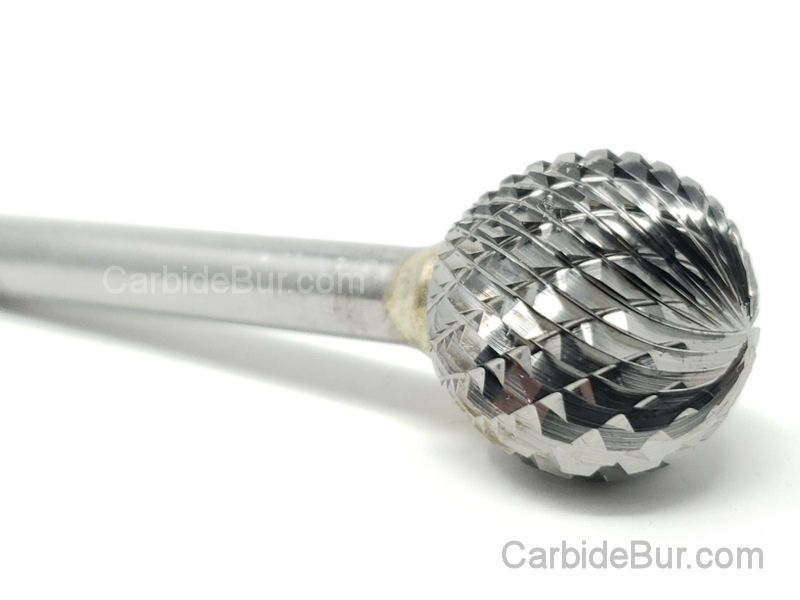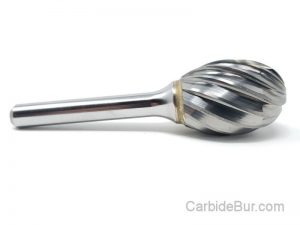How to Choose the Best Carbide Burr Tool for Your Material and Application
In the world of manufacturing and craftsmanship, the choice of tools can make a significant difference in the quality of the final product. Carbide burrs are indispensable for tasks involving precise cutting, shaping, and grinding of various materials. However, selecting the best carbide burrs for your specific material and application can be daunting with the myriad options available. This guide will unravel the complexities surrounding carbide burr selection, focusing on how to choose carbide burrs for aluminum, stainless steel, wood, and composite materials. Whether you’re a seasoned metalworker or a DIY enthusiast, understanding the unique features, shapes, and benefits of these versatile tools will enhance your work and efficiency.
Understanding Carbide Burrs
Carbide burrs are essential tools for various materials, offering precision in cutting, shaping, and grinding. Knowing their key features and benefits is crucial for making the right choice.
Key Features of Carbide Burrs
Carbide burrs are primarily made from tungsten carbide, a durable and wear-resistant material that ensures longevity. Hardness is a notable feature, allowing these burrs to maintain cutting edges longer than other materials. Additionally, carbide burrs usually have a flute design, which affects cutting efficiency.
The geometry of burrs is another key feature. They come in various shapes, such as cylindrical, ball-shaped, and conical, each suited for specific tasks. For instance, cylindrical burrs are ideal for flat surfaces, while ball-shaped burrs excel in detailing contoured areas.
Carbide burrs are available in both single and double-cut versions. Single-cut burrs are best for softer materials, while double-cut burrs provide smoother finishes on harder materials. Understanding these features can help in selecting the right burr for your application.
Benefits of Using Carbide Burrs
Carbide burrs offer numerous advantages, making them a preferred choice in manufacturing and craftsmanship. Firstly, their durability ensures long-lasting performance, reducing the need for frequent replacements. This quality is crucial for cost-effective operations.
Secondly, carbide burrs provide precision and control. Their sharp edges allow for accurate cuts and smooth finishes, which are vital in fine work. The efficiency of carbide burrs also translates to time savings, as they achieve desired results quicker than other tools.
Moreover, these burrs are versatile, suitable for a wide range of materials, including metals, wood, and composites. This adaptability makes them an invaluable tool for various industries. Additionally, their ability to handle high-speed applications without losing integrity further underscores their utility.
Choosing the Right Burr for Aluminum
Aluminum poses unique challenges due to its softness and tendency to clog. Selecting the best carbide burrs for aluminum can enhance work quality and efficiency.
Best Carbide Burrs for Aluminum
When working with aluminum, it’s crucial to choose carbide burrs designed to minimize clogging and maximize efficiency. Single-cut burrs are often recommended for aluminum, as they allow for deeper cuts and effective chip removal. Aluminum-specific burrs typically feature wider flutes to reduce loading.
A popular choice for aluminum is the ball nose burr, which offers smooth, controlled movements ideal for shaping. Additionally, flame-shaped burrs can handle intricate designs and recesses effectively.
When selecting burrs, consider those with a coating like titanium nitride. This coating enhances performance by reducing friction and heat build-up. For further insights on choosing the right burr for aluminum, visit empireabrasives.com.
Tips for Aluminum Applications
Working with aluminum requires specific techniques to achieve optimal results. Here are some practical tips:
-
Use adequate lubrication to prevent clogging and overheating.
-
Select the appropriate burr speed to minimize chatter and ensure smooth cuts.
-
Regularly check burrs for wear and replace them as needed to maintain efficiency.
Additionally, maintaining a consistent cutting angle can help in achieving uniformity. For more on aluminum applications, toolstoday.com provides useful guidance.
Selecting Burrs for Stainless Steel
Stainless steel is a tough material that demands specific carbide burrs for efficient processing. Understanding the characteristics of carbide burrs for stainless steel can greatly affect the quality of your work.
Carbide Burrs for Stainless Steel
Carbide burrs designed for stainless steel must withstand its hardness and toughness. Double-cut carbide burrs are often preferred as they provide smoother finishes and control over the material. Their cutting edges are designed to handle the dense structure of stainless steel.
Another important consideration is the shape of the burr. Cylindrical or tree-shaped burrs are ideal for stainless steel, allowing for effective material removal and precision in tight spaces. For best results, consider burrs with coatings like titanium nitride, which reduce friction and wear.
For more insight, carbideburr.net offers a comprehensive selection of burrs suited for stainless steel.
Considerations for Stainless Steel Work
When working with stainless steel, certain factors should be considered to achieve optimal outcomes:
-
Maintain a consistent speed to prevent overheating and tool damage.
-
Use cooling agents to preserve the burr’s integrity and extend its lifespan.
-
Ensure the burr is sharp, as dull edges can lead to poor-quality cuts and increased workload.
Proper technique and tool care are essential for successful stainless steel applications. More details can be found at carbideburr.net.
Carbide Burrs for Woodworking
Woodworking requires burrs that offer control and precision. Selecting the best carbide burrs for wood enhances the quality and efficiency of projects.
Best Carbide Burrs for Wood
Carbide burrs for woodworking should offer sharpness and longevity. Single-cut burrs are often ideal for softer woods, providing clean cuts and reduced splintering. For harder woods, double-cut burrs offer more control and smoother finishes.
The shape of the burr is also pivotal. Ball-shaped burrs are excellent for creating concave cuts and shaping, while cylindrical burrs are suitable for flat surfaces. Choosing the right burr coating can also enhance performance by reducing heat.
For further guidance, explore options at toolstoday.com.
Techniques for Wood Applications
Using carbide burrs effectively in woodworking involves specific techniques:
-
Maintain a steady hand to ensure precision and avoid unwanted gouges.
-
Adjust speeds based on wood hardness to optimize cutting efficiency.
-
Use proper safety gear, such as goggles, to protect against flying debris.
Continual practice and the right tools will significantly enhance woodworking skills.
Working with Composite Materials
Composite materials, known for their unique properties, require specific considerations when using carbide burrs. Understanding the right burr selection can lead to better results.
Carbide Burrs for Composite Materials
Choosing carbide burrs for composite materials involves understanding their properties, which often include a combination of materials like glass, carbon, and resins. Diamond-cut burrs are typically preferred for composites due to their ability to handle diverse material structures.
The shape and flute design of the burr are crucial. Tapered burrs can efficiently reach tight areas, while flame-shaped burrs are ideal for detailing. Additionally, selecting burrs with enhanced durability is important for managing the abrasive nature of composites.
To explore suitable options, visit abrasive-systems.co.uk.
Effective Use for Composite Tasks
Handling composite materials with carbide burrs requires careful attention:
-
Select the correct speed to prevent material damage and ensure clean cuts.
-
Utilize cooling methods to avoid overheating and maintain burr efficiency.
-
Regularly inspect burrs for wear due to the abrasive nature of composites.
Proper technique and tool maintenance will lead to successful composite material applications.
The Science of Airflow: How Carbide Burs Boost Engine Performance
The Science of Airflow: How Carbide Burs Boost Engine Performance Most mechanics miss how subtle changes in tool shapes affect airflow science inside engines. Carbide burs, when chosen right, can boost engine efficiency by fine-tuning [...]
Carbide Burs: Your Secret Weapon Against Common Porting Disasters
Carbide Burs: Your Secret Weapon Against Common Porting Disasters Porting disasters happen more often than you think—and they usually trace back to the wrong tools. Rough cuts, warped surfaces, and uneven edges turn hours of [...]
Maximizing Your Investment: The Long-Term Benefits of Carbide Burs Over Cheap Tools
Maximizing Your Investment: The Long-Term Benefits of Carbide Burs Over Cheap Tools Cheap tools wear out faster and slow your production down. When you factor in cost per horsepower, those small savings turn into big [...]
From Stock to Supercar: How Carbide Burs Boost High-Performance Builds
From Stock to Supercar: How Carbide Burs Boost High-Performance Builds Most engine modifications stall when the right tools aren’t on hand. Pro engine builders trust carbide burs to push performance heads beyond stock limits. These [...]
Precision Engineering: Achieving Mirror-Finish Ports with Carbide Burs
Precision Engineering: Achieving Mirror-Finish Ports with Carbide Burs Most cutting tools wear out before they deliver a true mirror finish. You’ve seen ports that fall short on flow and surface quality, costing time and precision. [...]
Carbide Burs: The Ultimate Tool for Cutting Porting Time in Race Shops
Carbide Burs: The Ultimate Tool for Cutting Porting Time in Race Shops Most race shops still spend hours grinding ports the old way—wasting time and missing out on faster results. Carbide burs are changing that [...]
The Benefits of Die Grinder Extensions for Professionals
Precision in Challenging Projects: The Benefits of Die Grinder Extensions for Professionals Tired of struggling to reach those tricky spots with your die grinder? You're not alone. Many professionals face the same challenge, especially when [...]
The Ultimate Guide to Choosing the Right Carbide Bur Tool Bits for Every Crafting Need
The Ultimate Guide to Choosing the Right Carbide Bur Tool Bits for Every Crafting Need Tired of Dremel bits that wear out after just a few projects? Meet our carbide bur tool bits, crafted for [...]
Why USA Made Carbide Burs Are the Smart Choice for Machinists
Why USA Made Carbide Burs Are the Smart Choice for Machinists You've heard the buzz about USA made carbide burs, but why should you choose them over high speed steel tools from China? Picture this: [...]
The Role of Carbide Bur Tools in Modern Foundries
Enhancing Machining Efficiency: The Role of Carbide Bur Tools in Modern Foundries Tired of wasting time and money on inefficient tooling solutions for your metal castings? Imagine cutting through tough materials with ease, reducing downtime, [...]
When to Use Carbide Burs vs Diamond Burs in Your Manufacturing Process
Unlocking Precision: When to Use Carbide Burs vs Diamond Burs in Your Manufacturing Process Precision in manufacturing isn't just a goal—it's a necessity. Yet, choosing between carbide burs and diamond burs can feel like navigating [...]
Empower Your Woodcarving Techniques with Our Carbide Cutting Tools
Empower Your Woodcarving Techniques with Our Carbide Cutting Tools You know the frustration of dull tools slowing down your woodcarving projects. Imagine transforming your creations effortlessly with the precision of our carbide burs. These woodcarving [...]



Leave A Comment
You must be logged in to post a comment.